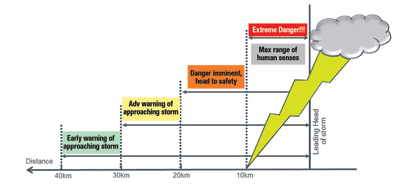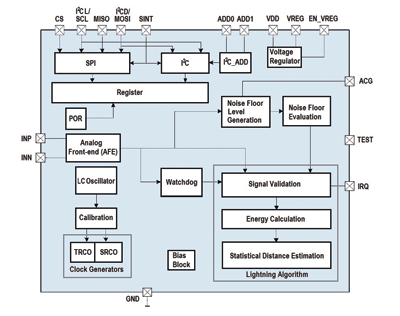Designing truly portable lightning detectors
Lightning detectors can play a crucial role in protecting people as well as equipment in locations prone to violent lightning storms
BY JOHNSY VARGHESE and
RUGGERO LEONCAVALLO
ams AG
www.ams.com
Weather forecasting over the years has been transformed, from “instincts of farmers” to a much more scientific approach that helps the average citizen be aware of predicted weather before pursuing any outdoor activity. But while an early morning forecast may be helpful, weather can change quite quickly in many parts of the world…and there really aren’t a lot of real-time, reliable options for those who spend much of their time outdoors, whether by choice or necessity.
The National Oceanic and Atmospheric Administration (NOAA) states that lightning strikes are second only to flooding as a cause of weather-related deaths in the U.S. Further, the number of non-fatal injuries due to lightning can be significantly greater than the number of deaths (see www.struckbylightning.org). Research conducted by the National Lightning Safety Institute in 2008 suggests that the cost of damage from lightning may exceed $5B to $6B annually ( www.lightningsafety.com/nlsi_lls/nlsi_annual_usa_losses.htm).
It is estimated at any given moment there are approximately 1,800 thunderstorms in progress throughout the world. And lightning strikes are likely to increase: Chinese scientists have warned that global warming is likely to intensify extreme weather patterns (China Meteorological Administration, 30 July, 2007), and severe storms in recent years may be a prelude to this.
So lightning detectors can play a crucial role in keeping people from harm and protecting equipment from damage in locations that are prone to violent lightning storms. On a golf course, baseball field, or many other outdoor venues, the extra time that a lightning detector can provide could mean the difference between life and death.
Lightning and our senses
At best, our senses can detect thunder and lightning up to about 6 miles (10 km) away, but that distance can be reduced by terrain and/or noise sources. While the speed of isolated storms is typically about 12 miles (20 km) per hour, some storms move much faster. In extreme circumstances, a supercell storm may move about 40 to 50 miles (65 to 80 km) per hour.
So at a distance of 6 miles from the head of a storm, a person relying solely on their own senses may have very little time to take cover. And not only can storms move very fast, but lightning can strike at angles, not just straight down (see Fig. 1 ).

Fig. 1: The further away lightning storm is when it is detected, the better able a person (or system) is to act safely. By the time human senses can detect a storm, it may already be too late.
To be effective, it’s imperative that any early-warning system allow sufficient time for people to take cover. Doubling, or better quadrupling, the sensor-to-head-of-lightning-storm distance at which people can be alerted to an on-coming storm will provide the advanced warning they need.
EMP in lightning
In the 19th century, Alexander Stepanovich Popov noticed that it was possible to detect lightning using a simple am-radio receiver; this was the first electrical system capable of predicting a storm. In fact, lightning emits electromagnetic energy, from very low frequencies all the way up to X-ray bands. The intensity of the electromagnetic pulse (EMP) phenomenon displays a 1/f behavior: the emissions are at their strongest at low kilohertz frequencies, and weaken as frequency rises. Popov was able to hear the signal produced by lightning using a simple system with an amplifier, down-mixer, and a low-pass filter.
Similar technology is still in use today in personal lightning detectors sold to consumers. Although the American Meteorological Society does not recognize the reliability or value of these portable devices, they can, under the right conditions, detect lightning within a small area.
But not only are these rudimentary devices expensive, they are of limited use since they cannot estimate the distance from the head of the storm, nor can they reliably differentiate lightning from various sources of interference. False triggers can result from such electrical devices as microwave ovens, fluorescent ballasts, motors, car engines, and camera flashes. After a few false alarms, people tend to simply turn off such detectors.
These sensors are unable to detect cloud-to-cloud lightning (which usually precedes cloud-to-ground strikes) which can actually be very useful in recognizing a storm. Furthermore, as such systems are based on discrete solutions, they are not optimized to minimize current consumption, and thus their battery life is limited to a couple of weeks. As is often the case with battery-operated flashlights, consumers find that when they really need it, it isn’t working. What is needed is a device that is reliable and provides a timely warning capability. It should be capable of being built into a personal device so that it is always at hand. It should reliably distinguish lightning signals from other sources of EMP, and accurately measure distance to a storm that is 30 km or more away.
Narrowband detection
As previously mentioned, there are two kinds of lightning: cloud-to-cloud (or intra-cloud) and cloud-to- ground. In terms of electromagnetic analysis, the huge currents generated in storms produce wideband signals across a large spectrum. Monitoring such a wide frequency range is next to impossible with a portable consumer device. Fortunately, Popov’s experiments proved that a narrowband system could pick up signals from lightning. But how accurate is this narrowband signal?
In fact, lightning is a complex combination of several different events — breakdown, return strike, in-cloud activity, and subsequent strike which give it a unique electrical signature. In “Review of Measurements of the RF Spectrum of Radiation from Lightning,” (Meteorology and Atmospheric Physics , Vol. 37, No. 3, 1987) D.M. Le Vine established that it is possible to detect a lightning signature with a narrowband system, even if some detail in the shape of the signal is lost.

Fig. 2: Comparing broadband and narrowband signal reception from a single lightning event shows that, at 500 kHz, narrowband data can provide the information required to identify a lightning storm.Le Vine’s paper also noted that lightning’s emissions peak is around 5 kHz and drops off as a function of 1/f. So if the center frequency of a narrowband receiver is set too high, the received signal strength falls, to the point where it is hard to distinguish lightning from other, interfering sources of EMP.
But while signal strength is much greater at a low frequency, at very low frequencies the antenna becomes too bulky to be accommodated in a portable device. There is, therefore, a trade-off to be made between signal strength and device size, with the most suitable center frequencies for detection being between a few hundred kilohertz and a few megahertz., For instance, there is a close match between a broadband electric field and the signal picked up with a narrowband receiver whose center frequency is 500 kHz (see Fig. 2 ).

Fig. 2: Comparing broadband and narrowband signal reception from a single lightning event shows that, at 500 kHz, narrowband data can provide the information required to identify a lightning storm.
Pattern-matching
While a low-frequency receiver can sense the emissions from lightning strikes, the bigger challenges in producing a reliable and useful lightning detector are as follows:
Rejecting signals from other emitters that cause false alarms, Accurately estimating the distance between the sensor and the storm.
The key to providing this sort of capability is the use of algorithmic pattern matching, carried out in real time. In a new single-chip lightning sensor (see sidebar, “A unique lightning sensor”), an algorithm embedded in the chip hardware can reliably analyze a signal that has been detected by an external antenna and determine its nature.
The algorithm first analyzes the signal to determine if it has the signature of a true lightning strike; if it doesn’t have the proper lightning signature, the sensor identifies it as a man-made disturber, thereby minimizing false alarms. When a real lightning signal is detected, the sensor then calculates the estimated distance to the head of the storm.
This information can be provided to the user via an LCD, multiple LEDs, audio, or by some other means that product designers may devise. ■
Sidebar: A unique lightning sensor
The AS3935 Franklin Lightning Sensor IC from ams the first single-chip lightning sensor is a highly integrated RF receiver with numerous dedicated functions, including automatic antenna tuning, and a sophisticated algorithm that can detect cloud-to-cloud as well as cloud-to-ground lightning strikes. The sensor also provides distance estimation, helping identify approaching electrical storms before ordinary human senses can.

This is a block diagram of the AS3935 lightning sensor for low-power portable products
As seen in the block diagram, signals received from an external antenna are input directly to the analog front-end (AFE), where they are amplified and demodulated. The watchdog circuit continuously monitors the output of the AFE and alerts the integrated Lightning Algorithm block in the event of an incoming signal.
The Lightning Algorithm block validates the signal by checking the incoming signal pattern and determining the signal energy. The block can distinguish between lightning signal and man-made disturbers. Signals classified as man-made disturbers are rejected and the system automatically returns to listening mode to minimize current consumption. If the incoming signal is identified as coming from a lightning event, then the Statistical Distance Estimation block determines the distance to the head of the storm, typically within 2 ms.
In keeping with its potential use in a number of handheld consumer devices, the AS3935 draws little power: it can operate from a wide 2.4 to 5.5-V supply, with current consumption of only 60 µA in listening mode.
High integration enables use of the chip in very small form factors and numerous applications, such as key-chain fobs, watches, cell phones, GPSs, fish finders, and other portable devices. The chip can also be used in fixed wire-line, ac-powered equipment that’s used in smart grids, base stations, UPS devices, and many other types of equipment whose operation can benefit by the ability to prepare for adverse weather conditions.
Advertisement
Learn more about ams (formerly austriamicrosystems)





